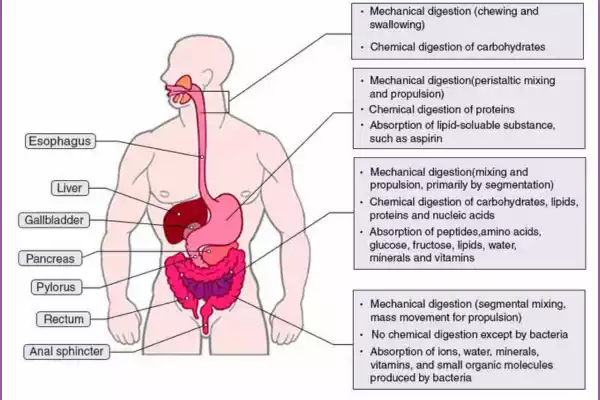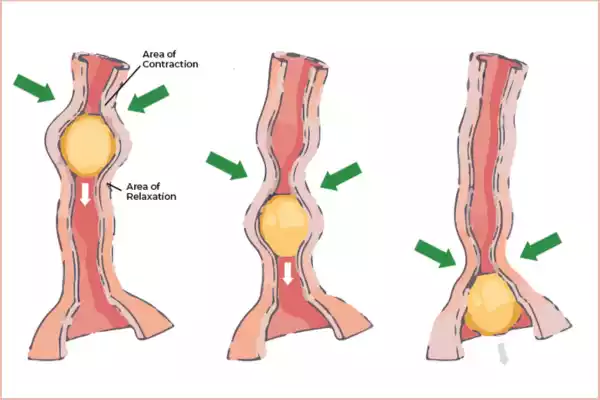Introduction of Primary and Secondary Peristalsis
Peristalsis is a crucial physiological process within the digestive system that enables the movement of food, liquids, and other contents along the length of the gastrointestinal tract. It plays a fundamental role in digestion, ensuring that ingested substances are transported efficiently from the mouth to the stomach and through the intestines for digestion and absorption.
Peristalsis can be broadly categorized into two distinct types: primary peristalsis and secondary peristalsis. Each type serves specific functions and operates under different conditions, contributing to the seamless functioning of the digestive system. Understanding the differences between primary and secondary peristalsis is essential for comprehending the complexities of digestive motility and the diagnosis and treatment of related disorders.
In this exploration, we will delve into the characteristics, locations, purposes, neural controls, and clinical significance of primary and secondary peristalsis, shedding light on their unique roles and importance in maintaining digestive health.
Definition of peristalsis
Peristalsis is a rhythmic, wave-like muscular contraction and relaxation of the muscles in the walls of tubular organs, such as the gastrointestinal tract (esophagus, stomach, intestines), urinary bladder, and even the esophagus.
This coordinated muscular action serves the primary purpose of propelling the contents of these organs forward, facilitating the movement of substances like food, liquids, or waste materials through their respective lumens or passages.
Peristalsis ensures the continuous and unidirectional flow of these materials, allowing for processes like digestion, absorption, and waste elimination to occur efficiently within the body.
What is Primary Peristalsis?
Primary peristalsis is the initial and coordinated wave of muscular contractions that occurs in the walls of the digestive tract, primarily in response to swallowing. This essential physiological process begins in the esophagus, continues through the stomach, and extends into the small intestine.

Here are the key characteristics and features of primary peristalsis:
- Initiation by Swallowing: Primary peristalsis is typically triggered by the act of swallowing. When food or liquids are ingested, sensory receptors in the throat and esophagus detect the swallow reflex, signaling the muscles to contract and move the contents downward.
- Coordinated Muscle Contractions: During primary peristalsis, the circular and longitudinal muscle layers in the digestive tract walls work in a coordinated manner. The circular muscles contract behind the ingested material (food bolus), narrowing the lumen of the organ, while the longitudinal muscles contract ahead of it, pushing the bolus forward.
- Location in the Digestive Tract: Primary peristalsis primarily occurs in the upper parts of the digestive tract, including the esophagus, stomach, and the initial segment of the small intestine (duodenum). These contractions help transport the swallowed contents from the mouth to the stomach and then into the small intestine for further digestion and absorption.
- Purpose and Function: The main purpose of primary peristalsis is to transport ingested food, liquids, and other materials through the digestive system. By moving contents in a coordinated manner, primary peristalsis facilitates the mechanical breakdown of food in the stomach and allows for the absorption of nutrients in the small intestine.
- Neural Control: Primary peristalsis is regulated by the autonomic nervous system, specifically the vagus nerve (cranial nerve X), which carries signals from the brain to initiate and coordinate muscular contractions. The myenteric plexus, a network of nerve cells within the digestive tract walls, also plays a role in controlling the timing and strength of these contractions.
Primary peristalsis is a fundamental process in digestion, ensuring that the food we consume progresses smoothly through the upper digestive tract, ultimately preparing it for further processing and absorption in the lower gastrointestinal tract.
What is Secondary Peristalsis?
Secondary peristalsis is a type of muscular contraction that occurs in the digestive tract in response to various stimuli other than swallowing. Unlike primary peristalsis, which is initiated by swallowing and occurs in a coordinated, sequential manner, secondary peristalsis is more localized and reflexive in nature.

Here are the key characteristics and features of secondary peristalsis:
- Non-Swallowing-Induced Contractions: Secondary peristalsis does not rely on the act of swallowing to initiate the muscular contractions. Instead, it can be triggered by a variety of stimuli, including the presence of food or liquid, distension (stretching) of the digestive tract, or irritation of the mucosal lining.
- Localized and Reflexive: Unlike primary peristalsis, which involves coordinated contractions along a relatively long segment of the digestive tract, secondary peristalsis tends to be more localized and can occur in response to specific sensory signals or irritants at particular points in the digestive system.
- Location in the Digestive Tract: Secondary peristalsis can occur at various locations along the digestive tract, depending on the stimulus or irritation. It is commonly observed in the esophagus, but it can also occur in other parts of the digestive system, such as the stomach or intestines.
- Purpose and Function: The primary function of secondary peristalsis is to clear the residual contents or irritants from a specific area of the digestive tract. For example, if there is reflux of stomach acid into the lower esophagus (as in gastroesophageal reflux disease or GERD), secondary peristalsis may be triggered to push the acid back into the stomach and prevent prolonged exposure to the esophageal lining.
- Neural Control: Secondary peristalsis is often initiated by local sensory receptors in response to mechanical or chemical stimuli. These receptors send signals to the enteric nervous system, a network of nerves within the digestive tract, to coordinate the reflexive contractions. While the vagus nerve may play a role in some instances, secondary peristalsis is primarily governed by local control mechanisms.
Secondary peristalsis serves as a protective mechanism for the digestive system, helping to prevent stasis (the stagnation of contents) and reflux (backflow of digestive juices or contents) in response to irritants or obstructions. It ensures that any materials that should not be in a particular part of the digestive tract are moved along or expelled to maintain digestive health.
Primary and Secondary Peristalsis comparison chart
Here’s a comparison chart highlighting the key differences between primary and secondary peristalsis:
| Aspect | Primary Peristalsis | Secondary Peristalsis |
|---|---|---|
| Initiation | Triggered by swallowing | Triggered by various stimuli/irritants |
| Coordination | Coordinated and sequential | Localized and reflexive |
| Location | Esophagus, stomach, small intestine | Variable occurs in response to stimuli |
| Purpose | Transport and propulsion of ingested material | Clearance of irritants/blockages |
| Neural Control | Vagus nerve and myenteric plexus | Local sensory receptors and reflex arcs |
| Primary Role | Moving food through the digestive tract | Preventing stasis and reflux |
| Sequential Pattern | Yes | No |
| Occurs in Response to Swallowing? | Yes | No (except in cases of swallowing-related secondary peristalsis) |
| Locations | Esophagus, stomach, duodenum (small intestine) | Various parts of the digestive tract |
| Involvement in GERD | Can contribute to GERD symptoms | Can help clear refluxed contents |
| Reflexive Nature | No | Yes |
| Importance in Digestive Health | Essential for digestion and nutrient absorption | Prevents damage from reflux and obstructions |
This chart provides a concise overview of the primary distinctions between primary and secondary peristalsis, focusing on their initiation, coordination, locations, functions, neural control, and roles in digestive health.
Neural control
Neural Control in Primary and Secondary Peristalsis:
- Primary Peristalsis:
- Initiation: Primary peristalsis is initiated by the act of swallowing. When you swallow, sensory receptors in the throat and esophagus detect the swallow reflex and send signals to the central nervous system.
- Neural Control: The primary peristalsis process is primarily under the control of the autonomic nervous system. Specifically, the vagus nerve (cranial nerve X) plays a pivotal role. The vagus nerve carries signals from the brain to initiate and coordinate the muscular contractions that move food through the digestive tract. Additionally, the myenteric plexus, a network of nerve cells within the digestive tract walls (part of the enteric nervous system), also contributes to the regulation of the timing and strength of these contractions.
- Secondary Peristalsis:
- Initiation: Secondary peristalsis is not initiated by swallowing but is instead triggered by various stimuli or irritants within the digestive tract. These stimuli are typically sensed by local sensory receptors.
- Neural Control: Secondary peristalsis relies on local control mechanisms. When irritants or obstructions are detected by sensory receptors in a specific area of the digestive tract, these receptors send signals to the enteric nervous system, which is the network of nerves within the digestive tract itself. The enteric nervous system then coordinates the reflexive contractions required to address the stimulus. While the vagus nerve may play a role in some instances, especially in the esophagus, local control mechanisms are the primary drivers of secondary peristalsis.
Primary peristalsis is centrally initiated and coordinated by the vagus nerve and the myenteric plexus, primarily in response to swallowing. Secondary peristalsis, on the other hand, is more localized and reflexive, relying on local sensory receptors and the enteric nervous system to respond to specific stimuli or irritations along the digestive tract.
Clinical Significance
Clinical Significance of Primary and Secondary Peristalsis:
Understanding the clinical significance of primary and secondary peristalsis is crucial for diagnosing and managing various gastrointestinal disorders.
Here’s how each type of peristalsis is clinically relevant:
Primary Peristalsis:
- Achalasia: Primary peristalsis can be affected in conditions like achalasia, where there is impaired relaxation of the lower esophageal sphincter (LES) and weakened peristaltic contractions in the esophagus. This leads to difficulty in swallowing (dysphagia) and can result in food and liquid accumulation in the esophagus.
- Gastroesophageal Reflux Disease (GERD): Disruption of primary peristalsis in the lower esophagus can contribute to GERD. When the lower esophageal sphincter fails to close properly, stomach acid can flow back into the esophagus, causing heartburn, regurgitation, and esophageal damage.
- Esophageal Motility Disorders: Primary peristalsis abnormalities can lead to various esophageal motility disorders, including ineffective motility, diffuse esophageal spasm, and nutcracker esophagus. These conditions can result in dysphagia and chest pain.
Secondary Peristalsis:
- GERD Management: Secondary peristalsis plays a protective role in preventing reflux. When stomach contents reflux into the esophagus, secondary peristalsis can be triggered to clear the acid or contents back into the stomach, reducing symptoms and potential esophageal damage.
- Esophageal Clearance: In cases of esophageal obstruction, strictures, or the presence of irritants, secondary peristalsis can help clear the obstructions or irritants, reducing the risk of complications and promoting normal swallowing.
- Motility Disorders Evaluation: The presence or absence of secondary peristalsis can be assessed during esophageal motility testing. This evaluation helps diagnose and differentiate between various motility disorders, providing valuable information for treatment planning.
- Functional Dysphagia: Secondary peristalsis is particularly important in cases of functional dysphagia, where no structural abnormalities are present, but patients experience difficulty swallowing. It helps identify and manage the underlying causes of dysphagia, such as sensory disorders or motility issues.
Primary peristalsis is essential for normal digestion and can be disrupted in conditions like achalasia and GERD. Secondary peristalsis is vital for preventing reflux, clearing obstructions, and managing various motility disorders. Both types of peristalsis have clinical significance in diagnosing and treating gastrointestinal conditions.
Conclusion
Primary peristalsis propels ingested materials through the upper digestive tract, primarily driven by swallowing, while secondary peristalsis acts reflexively to clear irritants and prevent reflux.
Both are clinically significant, with primary peristalsis disorders causing swallowing issues, and secondary peristalsis aiding in managing reflux and obstructions. Understanding these distinctions is essential for diagnosing and treating gastrointestinal conditions.
